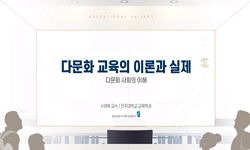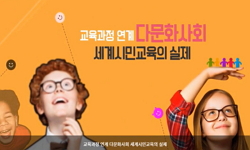본 연구는 우리나라 다문화 교육에 대한 인식과 양육실제를 알아 볼 뿐만 아니라 실제 중국거주 한국 부모와 일본부모의 다문화 교육에 대한 인식 및 양육실제를 비교해 보고자 한다. 본 연...
http://chineseinput.net/에서 pinyin(병음)방식으로 중국어를 변환할 수 있습니다.
변환된 중국어를 복사하여 사용하시면 됩니다.
- 中文 을 입력하시려면 zhongwen을 입력하시고 space를누르시면됩니다.
- 北京 을 입력하시려면 beijing을 입력하시고 space를 누르시면 됩니다.
https://www.riss.kr/link?id=T12361241
- 저자
-
발행사항
서울 : 한국방송통신대학교 평생대학원, 2010
-
학위논문사항
학위논문(석사) -- 한국방송통신대학교 평생대학원 , 유아교육학과 , 2010.8
-
발행연도
2010
-
작성언어
-
- 주제어
-
KDC
375.1 판사항(5)
-
발행국(도시)
서울
-
기타서명
Perception on Multicultural Education and parenting among Korean Parents in Korea, Korean and Japanese Parents in China
-
형태사항
82p. ; 26 cm
- 소장기관
-
0
상세조회 -
0
다운로드
부가정보
국문 초록 (Abstract)
본 연구에서는 다문화 교육에 대한 인식 및 양육실제를 측정하기 위해 정선희(1997), 하숙현(2000), 이미혜(2004)가 사용한 측정도구를 수정‧보완하여 사용하였다.
수집된 자료는 SPSS 12.0 프로그램을 이용하여 조사대상자의 일반적 특성을 알아보기 위하여 빈도, 백분율을 산출하였고, 연구문제에 따라 평균과 표준편차, t검증, Two-way ANOVA(이원분산분석)를 실시하였다.
본 연구에 나타난 결과를 살펴보면 다음과 같다.
첫째, 한국거주 부모와 중국거주 한국부모 및 일본부모는 다문화 교육이 필요하다고 인식하고 있었고, 한국거주 부모와 중국거주 일본부모는 ‘인간은 인종이나 성, 사회적 지위에 관계없이 모두 평등함을 알게 해 주므로’, 중국거주 한국부모는 ‘국제화시대에 필요한 융통성과 개방성 있는 유능한 인재 양성을 위해’ 가장 필요하다고 하였다.
둘째, 한국어머니의 한국거주와 중국거주, 취업유무, 학력에 따라서 다문화 교육에 대한 인식에 유의한 차이를 보였으며, 실제에서는 유의한 차이가 나타나지 않았으나 하위문항의 ‘성역할’, 문화적 차이와 유사성에서 유의한 차이가 있었다. 즉, 한국거주, 취업모, 4년대학 이상일수록 더 많이 인식하고 있었으며 인식에 비하여 실제에서는 충분하게 나타나지 않음을 알 수 있다.
셋째, 중국거주 한국어머니와 일본어머니는 다문화 교육 목표에서는 하위문항에서 유의한 차이가 나타났다. 양육실제에서 유의한 차이는 나타나지 않았지만 하위영역인 ‘성역할’에서 유의한 차이가 나타났다. 또한 학력에 따른 부모의 생각에서 4년대학 이상에서 한국어머니가 유의한 차이가 있었고, 실제에서 하위문항인 ‘성역할’과 ‘문화적 차이와 유사성’에서 유의한 차이가 나타났다.
넷째, 바람직한 양육실제가 나타나지 않는 이유로는 다문화 교육의 지도시 어려운 점으로 지적했던 ‘사회 전반적인 다문화 교육에 대한 인식의 부족’이나 ‘효율적인 지도방법을 몰라서’, ‘가정 내의 자료가 부족하여’ 가 그 이유가 될 수 있다.
본 연구는 우리나라 다문화 교육에 대한 인식과 양육실제를 알아 볼 뿐만 아니라 실제 중국거주 한국 부모와 일본부모의 다문화 교육에 대한 인식 및 양육실제를 비교해 보고자 한다. 본 연구의 대상은 서울시의 한국부모와 중국 광저우의 한국부모 및 일본부모 각각 207명, 116명, 67명이다.
본 연구에서는 다문화 교육에 대한 인식 및 양육실제를 측정하기 위해 정선희(1997), 하숙현(2000), 이미혜(2004)가 사용한 측정도구를 수정‧보완하여 사용하였다.
수집된 자료는 SPSS 12.0 프로그램을 이용하여 조사대상자의 일반적 특성을 알아보기 위하여 빈도, 백분율을 산출하였고, 연구문제에 따라 평균과 표준편차, t검증, Two-way ANOVA(이원분산분석)를 실시하였다.
본 연구에 나타난 결과를 살펴보면 다음과 같다.
첫째, 한국거주 부모와 중국거주 한국부모 및 일본부모는 다문화 교육이 필요하다고 인식하고 있었고, 한국거주 부모와 중국거주 일본부모는 ‘인간은 인종이나 성, 사회적 지위에 관계없이 모두 평등함을 알게 해 주므로’, 중국거주 한국부모는 ‘국제화시대에 필요한 융통성과 개방성 있는 유능한 인재 양성을 위해’ 가장 필요하다고 하였다.
둘째, 한국어머니의 한국거주와 중국거주, 취업유무, 학력에 따라서 다문화 교육에 대한 인식에 유의한 차이를 보였으며, 실제에서는 유의한 차이가 나타나지 않았으나 하위문항의 ‘성역할’, 문화적 차이와 유사성에서 유의한 차이가 있었다. 즉, 한국거주, 취업모, 4년대학 이상일수록 더 많이 인식하고 있었으며 인식에 비하여 실제에서는 충분하게 나타나지 않음을 알 수 있다.
셋째, 중국거주 한국어머니와 일본어머니는 다문화 교육 목표에서는 하위문항에서 유의한 차이가 나타났다. 양육실제에서 유의한 차이는 나타나지 않았지만 하위영역인 ‘성역할’에서 유의한 차이가 나타났다. 또한 학력에 따른 부모의 생각에서 4년대학 이상에서 한국어머니가 유의한 차이가 있었고, 실제에서 하위문항인 ‘성역할’과 ‘문화적 차이와 유사성’에서 유의한 차이가 나타났다.
넷째, 바람직한 양육실제가 나타나지 않는 이유로는 다문화 교육의 지도시 어려운 점으로 지적했던 ‘사회 전반적인 다문화 교육에 대한 인식의 부족’이나 ‘효율적인 지도방법을 몰라서’, ‘가정 내의 자료가 부족하여’ 가 그 이유가 될 수 있다.
다국어 초록 (Multilingual Abstract)
The subjects of this study were 207 kindergarten parents in Seoul, 116 kidergarten Korean parents and 67 kindergarten Japanese parents in Guangzhou, China.
In this research, Chung Sun Hee(1997)'s, Ha Sook Hyun(2000)'s, and Lee MI Hye(2004)'s questionare, which is modified and improved after preliminary research was used to measure parents' perception and practices about multicultural education.
The data collected were analyzed with the SPSS 12.0 program.
To find out the general characteristics of the respondents, statistical data on frequency and the percentage were obtained, and in order to compare their views and educational practices, mean and standard deviation were calculated, t-test, and Two-way ANOVA was performed.
The results shown in this study are as follows:
First, most of the Korean parents, Korean and Japanese parents living in China indicated the necessity of multinational education. Korean parents and Japanese parents in China responded that it would be helpful for children to know equalitarianism regardless of sex, nation, race, and social status. Meanwhile, Korean parents living in China thought that it would give children many benefits for them to be trained as an open-mind and flexible person responding to globalization.
Second, according to the result of this study about Korean parents, there manifests a meaningful difference in the perception of multi-cultural education by Korean parents in Korea and Korean parents in China, employed status, and educational level. No significant difference were found in childcare practice, but in sub-items 'gender', the cultural differences and similarities, represented meaningful differences. It seems that Korean parents in Korea, office workers, better educated were more likely to recognize it, but practice did not appear enough.
Third, Korean and Japanese Parents in China in the objects of multi-cultural education showed significant differences in sub-item. Although no significant differences were found in the area of practice, there were of significant differences in gender roles. In addition, from the view of the parents leveled with various academic degree, there was of a meaningful difference in the high-leveled korean parents. In sub-items 'gender', 'the cultural differences and similarities', manifested remarkable differences.
Fourth, the reasons that desirable practice doesn't come to reality are like this:
'less awareness about multi-cultural education' or 'no idea of how to teach efficiently ', 'the lack of reference material at home'
These were also indicated as difficult points while teaching multicultural education.
The purpose of this study was to find out perception on Multicultural Education and parenting among Korean Parents in Korea, Korean and Japanese Parents in China. The subjects of this study were 207 kindergarten parents in Seoul, 116 kidergarten Kore...
The purpose of this study was to find out perception on Multicultural Education and parenting among Korean Parents in Korea, Korean and Japanese Parents in China.
The subjects of this study were 207 kindergarten parents in Seoul, 116 kidergarten Korean parents and 67 kindergarten Japanese parents in Guangzhou, China.
In this research, Chung Sun Hee(1997)'s, Ha Sook Hyun(2000)'s, and Lee MI Hye(2004)'s questionare, which is modified and improved after preliminary research was used to measure parents' perception and practices about multicultural education.
The data collected were analyzed with the SPSS 12.0 program.
To find out the general characteristics of the respondents, statistical data on frequency and the percentage were obtained, and in order to compare their views and educational practices, mean and standard deviation were calculated, t-test, and Two-way ANOVA was performed.
The results shown in this study are as follows:
First, most of the Korean parents, Korean and Japanese parents living in China indicated the necessity of multinational education. Korean parents and Japanese parents in China responded that it would be helpful for children to know equalitarianism regardless of sex, nation, race, and social status. Meanwhile, Korean parents living in China thought that it would give children many benefits for them to be trained as an open-mind and flexible person responding to globalization.
Second, according to the result of this study about Korean parents, there manifests a meaningful difference in the perception of multi-cultural education by Korean parents in Korea and Korean parents in China, employed status, and educational level. No significant difference were found in childcare practice, but in sub-items 'gender', the cultural differences and similarities, represented meaningful differences. It seems that Korean parents in Korea, office workers, better educated were more likely to recognize it, but practice did not appear enough.
Third, Korean and Japanese Parents in China in the objects of multi-cultural education showed significant differences in sub-item. Although no significant differences were found in the area of practice, there were of significant differences in gender roles. In addition, from the view of the parents leveled with various academic degree, there was of a meaningful difference in the high-leveled korean parents. In sub-items 'gender', 'the cultural differences and similarities', manifested remarkable differences.
Fourth, the reasons that desirable practice doesn't come to reality are like this:
'less awareness about multi-cultural education' or 'no idea of how to teach efficiently ', 'the lack of reference material at home'
These were also indicated as difficult points while teaching multicultural education.
목차 (Table of Contents)
- Ⅰ. 서론 1
- 1. 연구의 필요성 및 목적 1
- 2. 연구 문제 5
- Ⅱ.이론적 배경 6
- 1. 다문화 교육 6
- Ⅰ. 서론 1
- 1. 연구의 필요성 및 목적 1
- 2. 연구 문제 5
- Ⅱ.이론적 배경 6
- 1. 다문화 교육 6
- 1) 다문화 교육의 개념 6
- 2) 유아기 다문화 교육의 필요성 9
- 3) 다문화 교육의 목표 및 내용 11
- 2. 부모의 역할과 태도 17
- 3. 한국과 일본의 다문화 교육 23
- Ⅲ. 연구 방법 28
- 1. 연구 대상 및 자료 수집 28
- 2. 연구 도구 30
- 3. 연구 절차 32
- 4. 자료 분석 33
- Ⅳ. 연구 결과 34
- 1. 다문화 교육에 관한 인식 34
- 1) 다문화 교육의 필요성 여부와 이유 34
- 2) 한국어머니의 거주지, 취업유무와 학력에 따른 다문화 교육에 대한 인식 36
- 3) 중국거주 한국과 일본어머니의 다문화 교육에 대한 인식과 학력에 따른 다문화 교육에 대한 인식 43
- 2. 다문화 교육에 관한 양육 실제 47
- 1) 한국어머니의 거주지, 취업유무와 학력에 따른 다문화 교육에 대한 양육 실제 47
- 2) 중국거주 한국과 일본어머니의 다문화 교육에 대한 양육실제와 학력에 따른 다문화 교육에 대한 양육 실제 51
- 3) 다문화 교육의 지도시 어려운 점 55
- Ⅴ. 논의 및 결론 56
- 1. 요약 및 논의 56
- 2. 결론 및 제언 61
- 참고문헌 64
- 영문요약 69












